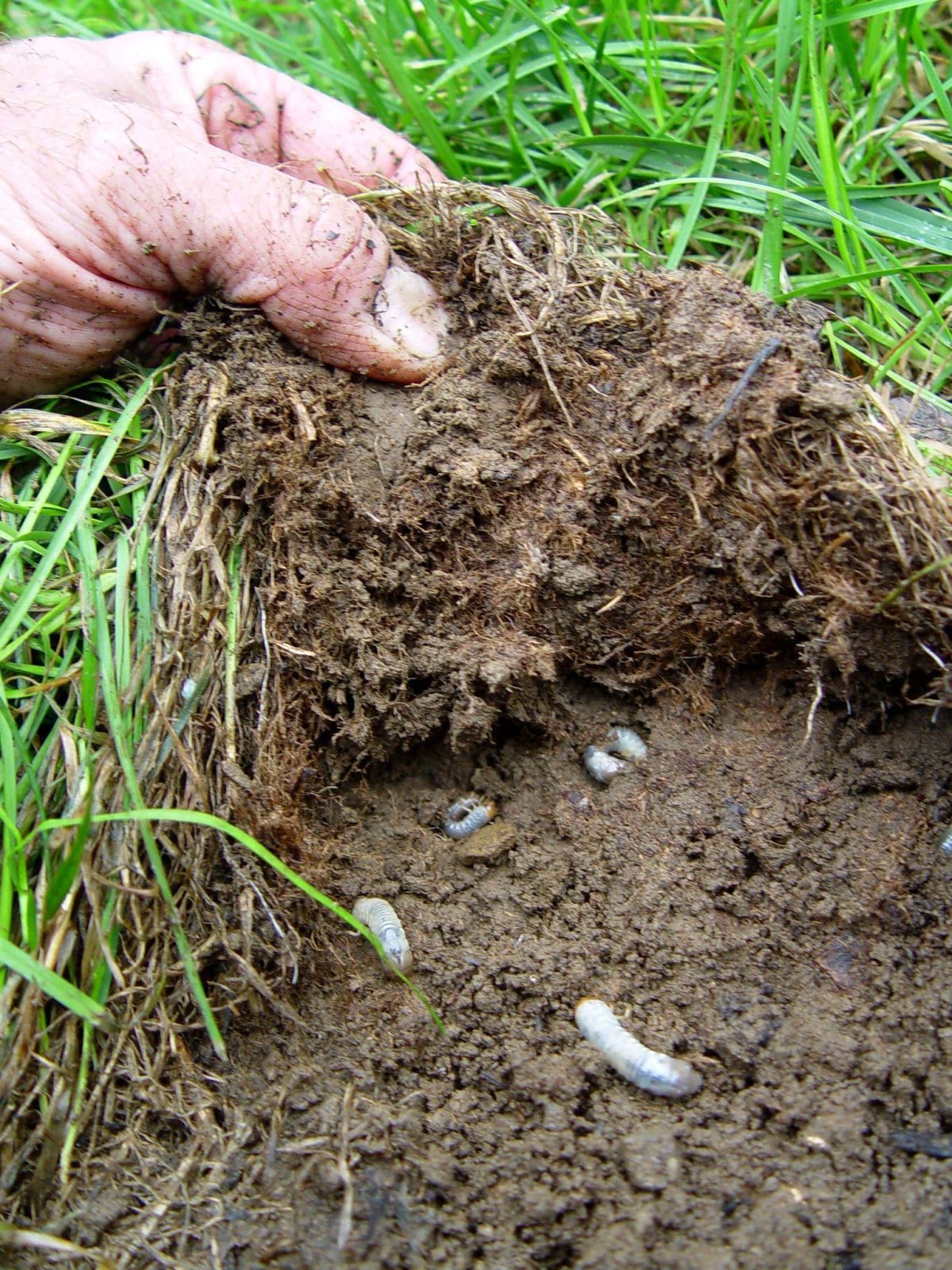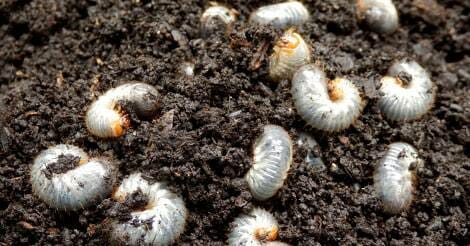Grubs can cause significant damage to your lawn, leaving it brown and patchy. These pests feed on the roots of grass, making it difficult for your lawn to absorb water and nutrients.
While chemical pesticides can be effective in getting rid of grubs, they can also be harmful to the environment and your health.
In this blog post, we discuss natural ways to get rid of grubs in your lawn, including using beneficial insects, applying nematodes, and promoting healthy soil.
These methods are not only effective but also safe for you and the environment. Say goodbye to grubs and hello to a lush, green lawn!
What are Grubs?

Grubs are scarab beetles in larvae form. They are also known as lawn grubs, grub worms, or white grubs. You can find them in many gardens and yards in North America, particularly Florida because the conditions are humid and temperate.
Grubs can thrive all year round in Florida because this region does not experience harsh winters.
Despite being called grubs, these creatures are insects. Some species stay in the larval stage for about 2 to 3 years, while others remain in this stage for a year before becoming beetles.
The scarab beetle species include the Japanese beetle, June beetle, Masked Chafer, and May beetle.
How Do Grubs Get In Your Lawn?
Grubs can get in your lawn through several ways:
- Adult beetles lay eggs in the soil, usually in late summer or early fall. The eggs hatch into grubs that burrow into the soil to feed on the roots of grass and other plants.
- Mowing or other activities that disturb the soil can bring grubs to the surface, making them more visible and vulnerable to predators.
- Birds and other animals can also spread grubs by eating and transporting them from one area to another.
- Grubs can also be transported through soil or sod that is being moved from one location to another.
- Grubs can also travel through underground tunnels, making it easy for them to move from one part of your lawn to another.
How Do Grubs Damage Your Lawn?
The extent of grub damage on your lawn depends on how big the population of these insects are in your yard.
While a tiny population of, say, below five grubs per square foot will not damage your grass, over ten grubs per square foot will lead to severe damage.
Grubs’ diet consists mainly of the roots of grass and organic matter found in the soil. So as these insects consume the grass roots in your lawn, they damage them, depriving your grass of soil nutrients and water. This makes the grass in your yard brown, patchy, and dead.
A large grub population on your property will also attract creatures that eat these insects, like ground moles, raccoons and birds, which will tear up and destroy your lawn to find the grubs.
Related: How to get rid of ground moles with vinegar
Signs of Grub Damage in Your Lawn
Below are the tell-tale signs of grub infestation on your lawn.
1. Yellowing grass
Your grass will become yellow, spongy, and easy to pull out as the grubs tear up the grass roots. The grasses roll back the same way a carpet would if you tug at them.
Also Read: Why is my grass turning yellow
2. Patchy, brown grass
Prior to pulling up and turning yellow, grub-infested grass becomes patchy and brown. This damage appears in random areas.
3. The presence of more beetles and moths
You may have a severe grub infestation if you see a large number of beetles and moths flying around the level of the grass.
4. White grubs on the lawn
Inspect your lawn for grubs by cutting around 2 to 4 inches deep on your grass, pulling back the square then examining the soil underneath.
5. The lawn looking drought-stricken
You probably have grubs in your yard if your grass looks like it is suffering from the effects of drought despite proper watering.
6. The presence of pests
Burrowing pests such as moles, raccoons and skunks will damage your lawn, looking for grubs. Therefore, you might have a grub issue if you see more of these pests on your lawn.
Related: Killing Moles with Marshmallows
How to Get Rid of Grubs in Your Yard Naturally

Below is how you can get rid of grubs in lawn naturally:
1. Introduce Beneficial Nematodes
Nematodes refer to small parasitic worms capable of killing many pests when introduced to lawns and gardens. You can purchase beneficial nematodes at a garden center and then introduce them to your lawn to get rid of grubs.
You can apply them late in the afternoon or early morning and avoid putting them in areas that receive direct sunlight.
After the first batch, you will need to add more twice or once annual
2. Limit Moisture
Moist soil provides a conducive environment for grubs to thrive. Therefore, if you can stop irrigating your lawn without harming the grass, you can kill young grubs and eggs, reducing the population of grubs. Just make sure your grass will recover once you introduce water again.
3. Introduce Grub-Eating Predators to Your Lawn
Although some grub predators damage your lawn, others are harmless. These include backyard chickens and birds like robins, blue jays, and chickadees.
Attract these predators to your property by adding birdbaths, birdhouses, and bird feeders to get rid of grubs in lawn.
4. Use Azadirachtin or Neem Oil
Azadirachtin and Neem Oil are usually considered the same thing, but that is not true. On the contrary, Azadirachtin is a substance in neem oil.
You can buy concentrated Azadirachtin to kill grubs or neem oil in pure form to discourage these insects from laying eggs, feeding, and growing.
Mix water and neem oil, then spray the solution on your lawn.
5. Dethatch and Aerate Your Lawn
Grubs use compacted, dense soil as shelter, so aerating your yard and removing thatch renders your lawn less conducive to grubs and other pests.
Furthermore, dethatching and aerating the lawn increases the effectiveness of natural solutions like nematodes and milky spore disease by allowing them to penetrate the soil easily.
6. Use Borax to Kill Grubs
This home cleaning agent effectively kills grubs but use it sparingly because it contains boron that can kill a lawn if used in high concentration.
Create a grub killer out of borax by adding a tablespoon of borax into a spray bottle full of warm water.
7. Use Soapy Water
Soapy water will effectively kill grubs in your lawn since the soap will smother these insects. Mix a gallon of water with 3 tablespoons of Dawn dish soap or organic liquid soap to create this grub killer.
8. Milky Spore
Control grubs in your lawn using this bacterial disease. Milky spore targets the Japanese beetles’ larvae.
While this natural grub killer is highly effective, it will take 2 to 3 years to become fully effective, but after that, it will provide biological control against grubs for 15 to 20 years.
Since milky spores are sensitive, pay attention to environmental conditions like soil type, temperature, soil PH, soil structure, and moisture when using this method.
Conventional Ways to Get Rid of Grubs
The conventional ways of eliminating grubs are:
1. Trichlorfon
Kills grubs within 1 to 3 days using Trichlorfon that contains organophosphate. The insecticide controls insects like white grubs, sod webworms, stink bugs, water scorpions, crickets, cockroaches, caterpillars, cattle lice, ants, and flies.
It is used in home lawns, golf courses, ornamental plants or shrubs, and meat and food processing plants’ non-food contact sections.
This chemical will break down after around 7 to 10 days. Use Trichlorfon in the fall or early spring for the best outcomes.
2. Carbaryl
This short-lived carbamate compound effectively kills grubs. It is considered more effective than Trichlorfon, and the grubs will die in 10 to 14 days.
Unfortunately, it is harmful to valuable insects like bees.
What About Preventive Chemicals For Grubs
Preventative measures for grub control work with curative methods to keep these destructive insects away.
Preventive methods contain chemicals like thiamethoxam, imidacloprid, or clothianidin and help lower the grub population on your lawn by 75% to 100% when applied in July or June.
You must also irrigate the yard with a minimum of 0.5 inches of water immediately after applying the chemicals.
FAQs
What Is The Best Time To Treat For Grubs?
Grub control is best applied in early spring to prevent the damage grubs would cause in the fall. On the other hand, treatment should be done the moment you confirm the presence of grubs in your yard.
In addition, the ideal time to treat your lawn for grubs may vary based on the region. For instance, introduce grub killer to your yard from April to May if you live in Massachusetts and early August in South Carolina and Connecticut.
Do Grubs Come Back Every Year?
Grubs will not come back to your lawn every year if you utilize the preventive measures, as they will eliminate most of the grubs that could cause damage the following year.
In addition, it is unlikely that the grubs in your neighbor’s lawn will spread to yours. Therefore, apply grub treatment only when you see grub damage signs.
Final Remarks
In conclusion, grubs can be a nuisance in lawns as they feed on the roots of grass, causing damage and brown patches.
However, there are natural ways to get rid of grubs in lawn without the use of harsh chemicals.
Some of these methods include:
- Introducing beneficial nematodes
- Using milky spore powder
- Introduce grub-eating predators to your lawn
- Using neem oil
- Dethatching and Aerating Your Lawn
- Mowing the lawn regularly
- Using soapy water
By implementing these natural methods, you can effectively control grub populations in your lawn and maintain a healthy and beautiful yard.
References
- University of Massachusetts Amherst: Beneficial Nematodes for the Control of White Grubs in Lawns
- Penn State University: [Neem Oil] Take control of grubs in your lawn

Hey there, I’m Derek Schew, a writer for Lawnholic.com, where we cover everything and anything related to lawns. As someone who’s spent countless hours tending to my own lawn, I’m passionate about sharing my knowledge and helping others achieve the perfect yard. From lawn care tips to product reviews, I’m committed to providing our readers with the most accurate and up-to-date information available. So whether you’re a seasoned lawn enthusiast or just getting started, I invite you to join our community and discover the joys of a lush, green lawn.
